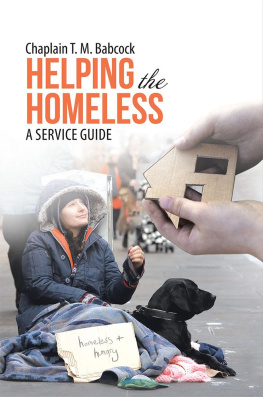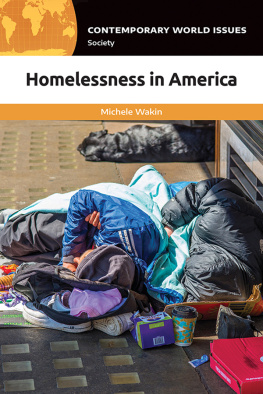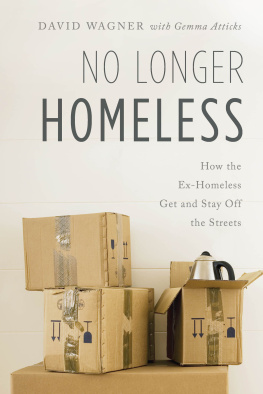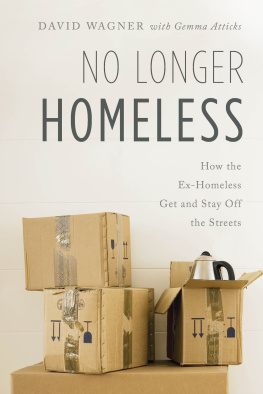Praise for Levys
Pretreatment Guide for Homeless Outreach & Housing First
Recently, Barbara Poppe, Executive Director for the U.S. Interagency Council on Homelessness (ICH) issued a challenge to Continuum of Care & Ten-Year Plan Leaders:
Today I want to address chronic homelessness, which is the first goal in Opening Doors. We have fewer than 1,000 days to bring the number of people experiencing chronic homelessness to zero; every day and every minute counts. For people living with disabilities and disabling conditions, every day or minute spent on the streets is another day or minute spent struggling to survive.
As one of these leaders and someone with 25 years of providing services to the homeless population, I felt that I had the answer to Ms. Poppes call to action; Mr. Levys book! As with his earlier works, Jay Levy engages the reader with poignant narratives of this extremely vulnerable group of people then, in this latest work, chapter by chapter builds an effective framework for truly solving this decades old social dilemma. I strongly recommend this book to anyone truly vested in Ending Chronic Homelessness.
Jerry Ray, Director of Homeless Services
Mental Health Association Inc. (Springfield, MA)
Jay Levy has now advanced his work with the chronically homeless into a comprehensive book. His Pretreatment Guide for Homeless Outreach & Housing First codifies his previous efforts and expands the knowledge base by providing new insights into helping and housing chronically homeless couples, unaccompanied youth and adults.
Through Jay Levys work, a cadre of social service workers and housing providers have come to better understand and adopt the principles of a housing first strategy and the importance of pretreatment model in the continuing struggle to end homelessness.
David W. Modzelewski, Housing Coordinator
Western Massachusetts Regional Network to End Homelessness
Pretreatment Guide for Homeless Outreach & Housing First is essential reading to both people new to the movement to end homelessness and folks who have been in the trenches for many years. Learn how to do effective outreach with the chronic homeless population, and the ins and outs of the Housing First model. The personal stories and the success cases will give inspiration to work even harder to help both individuals and for ending homelessness in your community.
Michael Stoops, Director of Community Organizing
National Coalition for the Homeless, Washington, DC
Pretreatment Guide for Homeless Outreach & Housing First could be a text book for a course on working with chronically homeless people. It is a hands-on manual full of caring, compassion and decency. The principles here applied to homeless people are those that should guide all helping relationships such as psychotherapy and social work. This is actually best expressed in the opening sentence of the last chapter: A pretreatment guide based on universal principles of care has been presented and applied to Homeless Outreach and Housing First activities. It is all evidence-based, and the authors expertise shines through.
A really valuable aspect of this book is the level of detail in the case studies. This makes it a primer for inexperienced therapists and social workers. Equally useful is the way in which the same principles are applied in different circumstances, cumulatively adding to their understanding. This is always fresh, never boring.
Bob Rich, PhD, AnxietyAndDepression-Help.com
Pretreatment Guide for Homeless Outreach & Housing First
Helping Couples, Youth, and Unaccompanied Adults
Jay S. Levy, MSW, LICSW
Foreword by David W. Havens, M.Ed.
Loving Healing Press
Pretreatment Guide for Homeless Outreach & Housing First:
Helping Couples, Youth, and Unaccompanied Adults
Copyright Jay S. Levy 2013. All Rights Reserved
Library of Congress Cataloging-in-Publication Data
Levy, Jay S., 1961-
Pretreatment guide for homeless outreach & housing first : helping couples, youth, and unaccompanied adults / Jay S. Levy, MSW, LICSW ; foreword by David Havens.
pages cm
Includes bibliographical references and index.
ISBN 978-1-61599-201-0 (trade paper : alk. paper) -- ISBN 978-1-61599-202-7 (hardcover : alk. paper) -- ISBN 978-1-61599-203-4 (ebook)
1. Homeless persons--Housing--United States. 2. Homeless persons--Services for--United States. I. Title.
HD7287.96.U6L48 2013
363.5--dc23
2013021591
Published by
Loving Healing Press Inc.
5145 Pontiac Trail
Ann Arbor, MI 48105
Tollfree 888-761-6268
FAX 734-663-6861
Distributed by Ingram Book Group (USA/CAN), Bertrams Books (UK).
Dedication
I dedicate this project to people without homes, and to all those who have survived homelessness, and to the outreach workers who help the most vulnerable among us. May their courage, strength and dedication serve as an inspiration to others.
Proceeds from this Book
The Author has pledged 25% of book royalties, and other related book profits, to a 501c(3) charity (e.g. National Coalition for the Homeless) that supports the cause of ending chronic homelessness.
Tables and Figures
Acknowledgments
I am indebted to my wife Louise for her love, patience, wisdom, and willingness to listen and critically respond. Thanks to my daughters, Talia and Sara, for taking the time to talk and play, while reminding me of teenage angst, rebellion, and their excitement for life. Thanks to Dave Havens for overseeing the REACH Housing First project and taking the time, care, and effort to compose the foreword. Additional thanks goes to Larry Gottlieb, Dave Modzelewski, and Jerry Ray for their tireless efforts to develop new and innovative programs to better serve chronically homeless individuals. Thanks to Eliot CHS-PATH Outreach and C-SPECH Housing First staff who on a day-to-day basis continue to help those who are most in need. Finally, and most importantly, thanks to my mom for making all things possible.
Permissions
Portions of this book have previously appeared in Homeless Outreach & Housing First: Lessons Learned (monograph), as well as in Homeless Narratives & Pretreatment Pathways: From Words to Housing. Specifically, Ronalds Narrative (Ch. 2) and Reasons for Ending Chronic Homelessness (Ch. 3) were reworked from the monograph, while Laceys Narrative (Ch. 6) and portions of Housing First (Ch. 9) and Supervision (Ch. 11) were reprinted from my book Homeless Narratives & Pretreatment Pathways. The addendum interview was previously published in the Journal of Humanitarian Affairs (GHNN). Thanks to Victor R. Volkman and Ernest Dempsey for encouraging my writing and granting permission to reprint these sections.
Confidentiality
The homeless narratives depicted in this work are based on actual persons and events from my experiences as an outreach counselor. However, names, places, and events have been altered to protect client confidentiality.
Foreword The REACH Housing First Pilot
The State medical examiner had just revealed his findings that a homeless man had been discovered deceased in an abandoned building in Springfield, and that his body showed signs of extensive flea infestation. The City Council committee that received the information ignored the glaring lack of service connections for this person, and instead responded to this tragic occurrence by publicly setting the full enforcement capacity of the Citys Code & Inspections Department upon any residential program serving persons with developmental disabilities, mental illnesses, addictions, domestic violence and homelessness. Suddenly, our efforts to determine how to provide substantial real help to people experiencing long-term homelessness and living on the streets shifted from a moral and intellectual challenge to a practical and political necessity. Thankfully, a political resolution was found and ended this misdirected hyper-enforcement against the residential components of the Citys human service sector. Afterward, homeless advocates struggled to find a way to promote safety by better caring for the underserved and hardest to reach people within our region. As it was the mid-1980s, there was a significant gap in our knowledge and practice, as well as the need to discover new effective ways for connecting with homeless persons who did not fit or could not access the traditional outpatient, residential, or shelter models of service.






